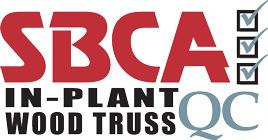Search
A spring Wisconsin snowstorm demonstrates how a building design practice may lead to higher risk.
Ever have one of those component jobs where everything went exactly to plan, only to have a hiccup at the last moment?
The BFS design team in Shelby, Alabama “collaborate on anything that doesn’t sit right,” says Thom Patton. One result: a roof that rests perfectly on a school building after a simplified build and easy install process.
Looking for an economical way to add square footage and an alternative to decreasing spans? Read on!
SBCA makes these Structural Details available to architects, engineers, contractors, designers, code enforcement officials and others involved in construction applications using metal plate connected wood trusses (MPCWT). SBCA hopes that these details will be of value, save time in the design process, and educate those in the proper application of MPCWT.
 QUALITY Speaks for Itself
QUALITY Speaks for Itself
Listed below are Frequently Asked Questions (FAQs) about SBCA In-Plant Wood Truss QC and SBCA’s Certification program. If you have any questions that were not addressed above, please contact SBCA staff.
The 2018 BCMC show runs from October 23-26 in Milwaukee, Wisconsin.
What to do when bearing capacity is insufficient
A best practice for building designers: find a friend to check your load paths.
Take a few minutes to learn more about the CMs serving as officers on the 2016 SBCA Board of Directors.
- The most effective way to avoid recurrent issues with component installation is to give an SBCA Jobsite Package to the general contractor and framing crew on every job.
- Simply having your driver drop the Jobsite Package off with the component package at the jobsite isn’t enough.
- Anytime you work with a GC or an inexperienced crew for the first time, consider visiting with them ahead of delivery and walk them through the information in the jobsite package.
SBCA is involved with “In-plant Quality Control” programs to fulfill its mission of members gaining the knowledge and power to run successful, growing, profitable companies offering a compelling competitive advantage in the marketplace for their customers and professional growth for employees.
When it comes to getting the right structural building components for a project, cost isn’t everything, but how do you convince the building designer? Communication is key.
This is the story of how a fire, a yacht race and America’s third wealthiest citizen proved a boon for one Texas-based structural component manufacturer.
A cybersecurity attack can happen quickly and be devastating
- We need to focus on our younger employees now and groom them to become the next generation of leaders in our companies and in our industry.
- Just like raising kids, building leaders is accomplished through a million small conversations, learning moments, completed tasks and informal evaluations with feedback.
- There has to be a commitment on your part to ensure the employees you mentor learn everything they can about their jobs and the business.
- Combining fiber reinforcement with finger jointed lumber could be a win for both the lumber and component industries.
- With in-line framing, CMs can remove studs and plate material, and spread the stud spacing out to 24", which, in some cases, allows for better insulation methods.
- The key to new product development is generating sales revenue immediately by establishing design values and engineering reports that give assurance of the product’s equivalent code-compliant performance.
- Not stating a SOW can also subject a CM to the prospect of increased claims and liability.
- A manufacturer should strongly consider developing a SOW template that can be used in its bids or proposals and as an addendum or attachment to the customer contracts it signs.
Builder complaints regarding the growth of surface mold on the lumber contained within wood structural components, while not as frequently encountered as in the past, continue to pose a dilemma in some markets. The dilemma comes in the form of builders either demanding moldfree wood based products, or when mold appears on a component at the jobsite, they are demanding that suppliers provide an immediate remediation (e.g., removal) of the mold, regardless of the cause or the cost. And, where structures are improperly designed or constructed and mold growth appears years later, component manufacturers (CMs) have found themselves into construction defect litigation with various types of complaints being asserted.
A tour can seal the deal with potential customers or cement a relationship with established ones.
From a South Florida Invention to a Worldwide Industry!
If you have a contribution you would like to make to this compilation, please send it to timeline@sbcindustry.com. Submissions will be subject to approval and may be edited for grammar, length and clarity.
- Scott Ward first implemented In-Plant WTCA QC in 1998 and has more than a decade of experience with the program.
- He reflects on the benefits he first saw when implementing the QC program and how QC helps differentiate his business based on the unique quality of their production.
- The In-Plant WTCA QC program’s biggest impact for Ward’s company has been training employees and reducing customer product issues and related costs.
Lay-On Gables are an opportunity for component manufacturers.
It’s not often that a component manufacturer (CM) is asked to do a project that publicly displays the components they design and manufacture. If done right, these opportunities have the potential to positively represent the industry to the entire community.
SBCA’s Jobsite Package is likely the most economical risk management tool a component manufacturer (CM) can deploy.
Fire Retardant Treated Wood (FRTW) products are permitted by code in certain situations where a fire resistance rating is required.




